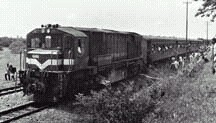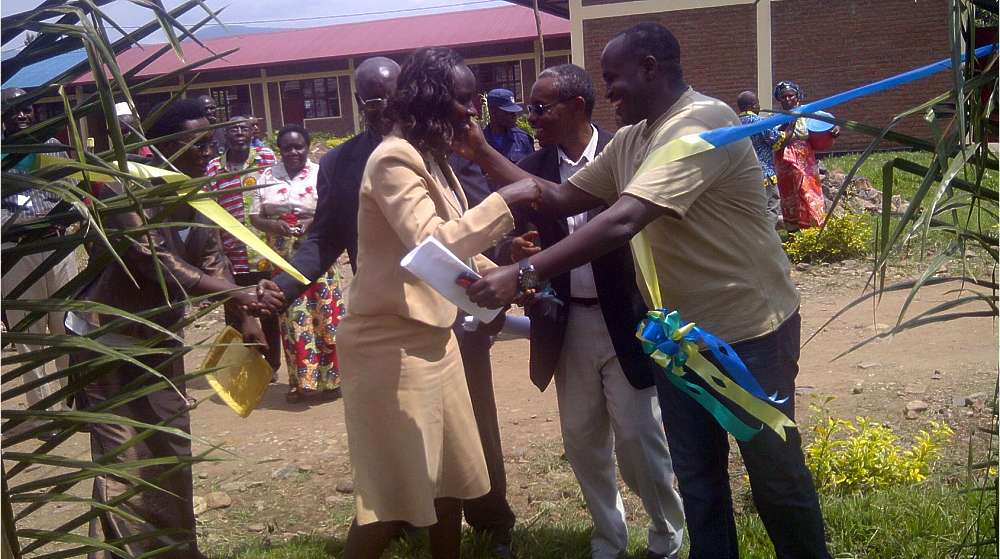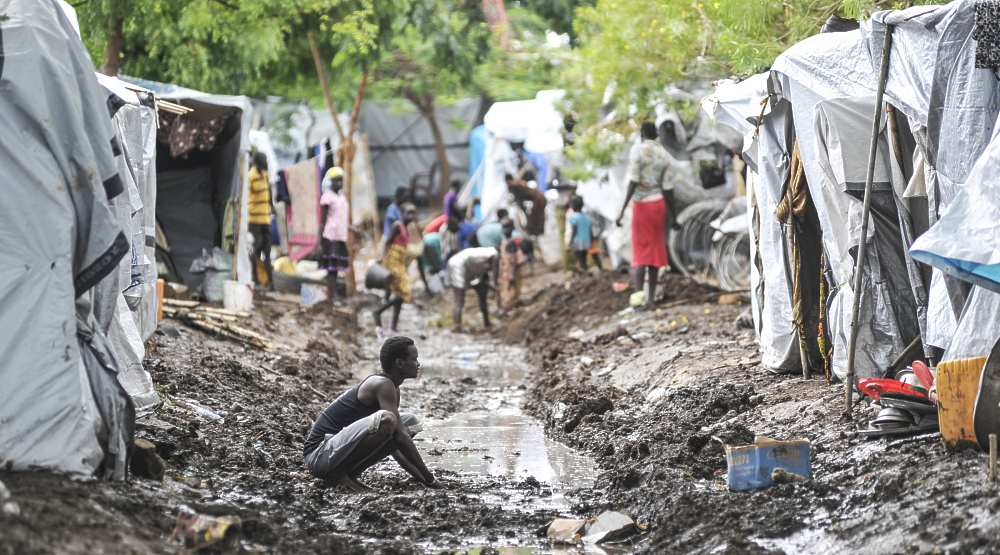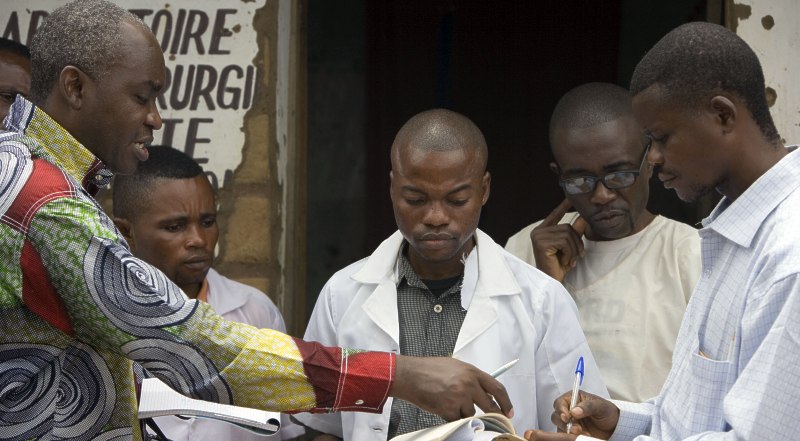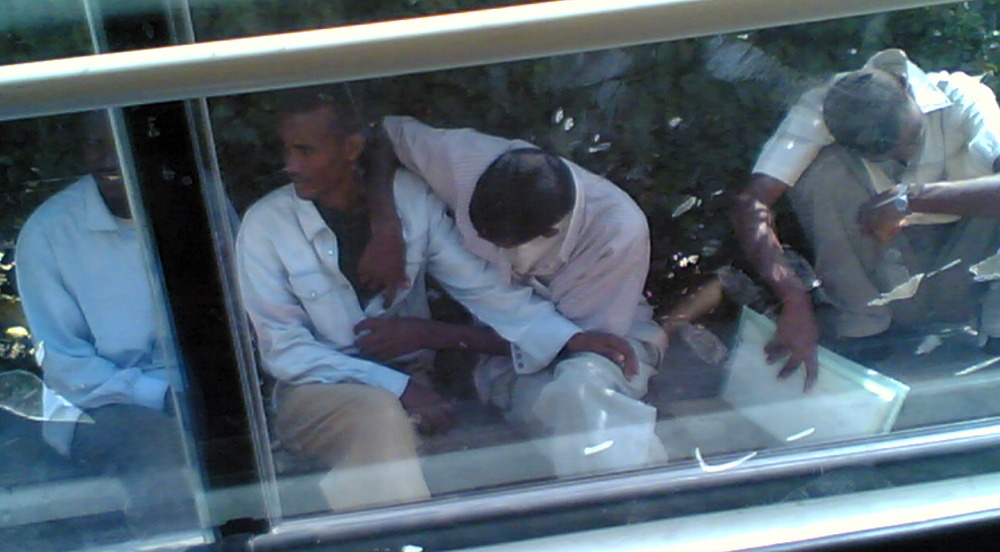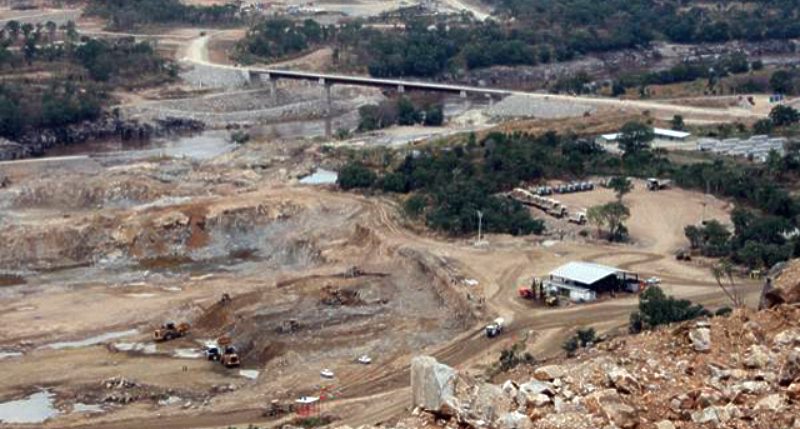|
Mozambique Economy - Development Mozambique: growth with poverty
Once it was a country struck by cyclical droughts and an apparently never-ending war. It often was called "the poorest country in the world." Yet the war did end (in 1992), political stability was sealed with multi-party elections (in 1994), and Mozambicans were able to start rebuilding, albeit under severe constraints. By the late 1990s, the economy had made remarkable progress, with double-digit growth rates. All this makes this year's floods a tragic setback. However, as the government points out, the greater part of the country was not flooded. It hopes that economic growth will continue to outstrip population growth, although it has revised downward its growth projections for this year several times, and now expects less than 4 per cent growth. Nevertheless, economic growth is not a panacea. Large increases in gross domestic product (GDP) coexist with grinding poverty for the bulk of the population. Achieving a formula for growth that also ensures poverty alleviation is now more critical than ever, since the heavy rains have thrust around 120,000 peasant families in the southern and central provinces into utter destitution. "If there is growth currently in Mozambique," asked the UN Development Programme's 1998 National Human Development Report on Mozambique, "what is growing and for whom? The growth of absolute poverty for the great majority, or the growth of ostentatious incomes for a small minority? The growth of social and civil security, or the growth of crime? Economic growth that promotes the human development of Mozambicans, or growth that is exported to soften the country's indebtedness? The growth of democracy and participation, or the growth of political apathy and abstention? The equitable growth of human development, or the inhuman deepening of inequalities between the sexes, and between social, ethnic and racial groups?" The flood crisis makes such questions more relevant than ever. From war to peace Whatever the difficulties of Mozambique's economic liberalization, nearly a decade of peace made it possible at least to begin the arduous tasks of reconstruction. After independence in 1975, initial progress in overcoming the Portuguese colonial legacy was reversed by the war waged by the rebel Mozambique National Resistance (Renamo), with direct backing from the apartheid regime in neighbouring South Africa. From the early 1980s, Mozambique was plunged into economic crisis. Production plummeted, half the rural primary schools were burned down or forced to close, the health network shrank by more than a third and the country began to default on debt repayments. By the time President Joaquim Chissano and Renamo leader Afonso Dhlakama signed a peace agreement in 1992, much of the country's physical infrastructure -- roads, bridges, railways, sugar mills, rural shops and much else -- lay in ruins. Annual per capita GDP had fallen from $133 in 1981 to $90 in 1993. This was a poor base for the government to build on in the post-war era. The ruling Frelimo Party won the first multi-party elections in October 1994, partly on the basis of a manifesto which stated its basic aim as solving the problems of the poor. It promised to reduce social inequalities and regional imbalances and promote "gradual and equitable distribution of the nation's wealth." Frelimo replayed these themes when it was re-elected in December 1999. Macro-economic growth The government's key development goals remain poverty reduction, improvements in education and health, and providing more jobs. According to Prime Minister Pascoal Mocumbi, the country needs at least 6-7 per cent annual GDP growth (and preferably 10 per cent or more) "if we are to emerge from the current situation." A second target has been bringing inflation under control. It hit 71 per cent in 1994 and aggravated poverty by eroding purchasing power. Mr. Mocumbi has warned that since the government no longer will impose price controls, "inflation can only be brought under control through restrictive monetary and fiscal measures." Since the mid-1990s, the targets of high growth rates, low inflation and currency stability have all been met, and the government has won praise from its international partners for its tight control over public finance. The GDP growth rate peaked at 11.3 percent in 1997 and averaged nearly 10 per cent in 1996-99. This is one of the highest rates in the world, although from an admittedly low starting point. The most spectacular gains have been in industry. After a deep crisis in the 1980s and early 1990s, manufacturing output grew by almost 50 per cent in 1997, and a further 16 per cent in 1998. The mining industry (mainly marble, bauxite and graphite) grew by around 30 per cent in 1997 and 1998, due in part to the lowering of mining taxes, which attracted more foreign mining companies. However, Mozambique remains highly vulnerable to the vagaries of the world market -- a collapse in world graphite prices in 1999 meant that exports no longer covered production costs, so work at the graphite mine in Ancuabe has been suspended. By 1997, the inflation rate had declined to 5.5 per cent, from 54 per cent in 1995. In 1998, for the first time, average prices actually fell and the inflation rate for the year was minus 1.3 per cent, before rising again to a modest 4.8 per cent in 1999. Significantly, these price falls were concentrated in foodstuffs, on which poor Mozambicans spend the bulk of their income. Low inflation went hand-in-hand with currency stability. In 1992 the Bank of Mozambique stopped fixing the exchange rate of the country's currency - the metical - and let it float according to supply and demand. The metical's depreciation against the US dollar became no more than a gentle slide, making it one of the most stable currencies in Southern Africa. This was achieved thanks in part to tight credit ceilings and control over the money supply, although this has posed difficulties for Mozambican businesses. The government has vowed that it will not resort to printing more money to pay its bills. Poverty in the countryside ... Despite this macro-economic "success story," 69 per cent of Mozambicans still live below the poverty line. As Prime Minister Mocumbi told donors in 1998, poverty "is an atrocious reality, particularly in the countryside where 80 per cent of the population lives." This rural poverty is intimately linked with rudimentary agricultural techniques. Only 7 per cent of farmers use traction (animal or mechanical) and only 2 per cent use fertilizers or pesticides. The dominant image of Mozambican agriculture remains that of a farmer (usually a woman, and often with a baby on her back) turning the soil over with nothing but a hoe. Peace and adequate -- if sometimes excessive -- rains have contributed to an agricultural recovery, despite some flood losses. The 1980s spectre of famine has vanished. There is no longer a chronic food deficit and Mozambique even made modest exports of maize (mostly to Malawi) in 1997 and 1998. Increased grain harvests are not due to higher productivity, however, but simply to an increase in the area under cultivation. Most peasant families have been unable to build up a reserve of food or money that would see them through a bad harvest. A disaster such as this year's floods plunges the affected areas into an immediate crisis and sends the government appealing once again for international food aid. Fragile marketing networks and the poor state of access roads add to the precariousness of small-scale farming. The state marketing body, the Mozambique Cereals Institute (ICM), is in theory the "buyer of last resort." It pays decent prices for any crops that farmers have been unable to sell, either because private buyers offer prices that are too low or because their trucks simply do not go to remote areas. In practice, however, the ICM has never secured enough credit from the banks to fulfil this role. If nobody comes to buy their crops, farmers in border areas just walk over the frontier and sell them in Tanzania or Malawi. The government takes a relaxed view of this. "It's better for peasants to have money in their pockets than maize rotting in their barns," was Mr. Mocumbi's reaction to suggestions by some Mozambicans that the government should intervene to halt this cross-border trade. ... and in the cities In the towns, most of the social and economic safety nets that existed under the previous centrally-planned economy have been withdrawn. There is no longer a basic ration of subsidized food for all and health services are no longer essentially free. The statutory minimum wage for industrial and office workers is now the equivalent of $30 a month. In the private sector, wages above the minimum are no longer set by government fiat, but are subject to collective bargaining. Where companies are doing exceptionally well, workers can earn much more than the minimum wage. But in many companies, even the minimum is not paid, or else workers are paid weeks or months late. In some cases, employers swindle their workers by docking social security contributions from their wages, and then failing to hand the money over to the national social security agency. The trade unions complain that workers alone are bearing the costs of the structural adjustment programmes under way since 1987. The Mozambican Workers' Organization (OTM), the main union federation, argues that more than 100,000 jobs have been lost over the past decade because of structural adjustment policies. The unions calculate that in order to meet the basic needs of an average family of five, a worker needs a monthly wage of 900,000 meticais ($76). But in the March-April 1999 round of negotiations between the government, the employers and the unions, the employers were not even prepared to consider a minimum wage of 500,000 meticais a month. Their offer was just 402,000 meticais. Eventually the government intervened to insist on 450,000 meticais, a figure which satisfied neither side. A year later, despite the unions' demands for annual wage rises, there had been no further increase. Unsurprisingly, the low wages and high unemployment have fueled an expansion of the informal sector. Social spending rises According to former Finance Minister Tomás Salomão, a rural Mozambican must walk an average of 46 kilometres to reach the nearest doctor, 66 kilometres to the nearest secondary school, and 48 kilometres to the nearest telephone. Faced with this situation, the government insists that building up "human capital" is key to breaking out of poverty, requiring substantial investments in education and health. Until 1994, defense spending was easily the largest single item of recurrent expenditure in the annual budget. But after the 1994 elections, resources were shifted, and each year saw a real increase in allocations to the social sectors. In the 1998 and 1999 budgets, the education and health ministries benefited from significant increases in both capital and recurrent allocations, while funds for the military and the intelligence service were cut. The trend continued in the 2000 budget, with rises in recurrent expenditure of 21 per cent for education, and no less than 80 per cent for health. Despite the February flooding, the government is confident that it can raise the tax revenue to fund these increases. By the end of 1998, the primary school network had recovered from the damage inflicted during the war. The number of first-level primary schools (first to fifth years) equalled and then surpassed the number that had been operating in 1983. There were 6,600 such schools by April 1999, attended by 2.1 million children. However, according to the education ministry's planning directorate, 32 per cent of primary schoolchildren attend schools that are so crowded that classes have to be given in three shifts a day. Even so, many children still cannot get a place in school. Currently, only 81 per cent of all 6-year-olds enter the first year of primary school, though this is much better than the 59 per cent figure in 1992. The education pyramid narrows dramatically after the fifth year. There are only 440 second-level primary schools (sixth and seventh years), and just 81 secondary schools in the entire country. Most children cannot go to secondary school, since there are simply not enough pl
The school system also is characterized by high dropout and failure rates, particularly among girls. The quality of education is poor, in part because teachers remain poorly paid, despite the budget increases. Modern health services reach only about 40 per cent of the population. For key public vaccination campaigns, mobile brigades are sent into remote areas, with great success. Indeed, the second dose of the 1998 vaccination against polio reached 111 per cent of the national target, partly, explained Health Minister Aurelio Zilhao, because many mothers from neighbouring countries brought their children into Mozambique to be vaccinated. Mozambique is now likely to qualify for World Health Organization certification as a polio-free country . But the shortage of clean drinking water, poor or non-existent sanitation in peri-urban areas, and inadequate refuse collection facilitate the spread of epidemics. Cholera raged in much of the country from 1997 to 1999. Over 2,000 people died in the outbreak, although the government claimed that the death rate was lower than in Tanzania or Malawi. Fears that the recent floods would bring a major upsurge in cholera proved unfounded. However, the receding waters left behind stagnant pools, ideal breeding grounds for malaria-carrying mosquitoes. Health units across southern Mozambique have reported a sharp increase in cases of malaria, the most common life-threatening disease in the country. Industrial projects draw investment One of the government's main goals is to attract foreign investment, particularly in large enterprises that could generate thousands of jobs. The largest project is the $1.3 bn MOZAL aluminium smelter on the outskirts of Maputo, which began production in June 2000. The main shareholders are the London-based metals company Billiton, Mitsubishi of Japan, and the South African Industrial Development Corporation. The construction phase created around 7,000 temporary jobs, but there will only be 800 full-time staff when the smelter is fully operational, probably by March 2001, when its annual output is expected to reach 250,000 tonnes. All of this will be for export, and at an anticipated value of $400 mn, the aluminum will earn Mozambique more than all exports combined in 1999. MOZAL will need 400 megawatts of power, more than double current national electricity consumption. Initially, power for MOZAL will come through South Africa: the Mozambican, South African and Swazi electricity companies have formed a consortium to supply the smelter via a new powerline. An even larger project on the drawing board is a factory to produce steel slabs in Maputo, using South African iron ore and Mozambican natural gas. This would entail a $1.6 bn investment and another $600 mn to build a gas pipeline. However, negotiations between the Mozambican government and the US corporation Enron stalled for more than a year over terms for exploiting the Pande gas field in Inhambane province. Agreement was finally reached in April 1999, giving Enron rights over a larger area than the government had initially wanted. Another US company, Atlantic Richfield, with its partners SASOL of South Africa and Zarara Petroleum of Dubai, is developing a gas field south of Pande, at Temane. There are plans to use this gas in an iron ore plant in the Beira area. If this project goes ahead, it will require building a new deep-water port at Savane, some 30 kilometres north of the existing port of Beira. The giant Cahora Bassa dam on the Zambezi, which is majority Portuguese-owned, has an enormous power generation capacity of 2,075 megawatts, but the restoration of its power lines in December 1997, following the damage inflicted during the war, will not directly ease national power needs. The transmission lines bypass Maputo and run directly to South Africa, historically the main buyer of electricity from Cahora Bassa (although a pricing dispute impeded resumption of actual sales until 1999). Feasibility studies are under way for a second power station at Cahora Bassa, and a new dam at M'panda-Ncua, 70 kilometres downstream from Cahora Bassa. New generating capacity will certainly be required for the mega-projects in the north and centre. Besides the Beira iron plant, these include a second aluminium smelter, also in the Beira area, and a titanium smelter in Nacala. Meanwhile, prospecting for oil continues. Focus on transport Despite the war, major upgrading of transport infrastructure took place in the late 1980s and early 1990s, including rehabilitation of Beira port and the rail lines from Beira and Maputo to Zimbabwe and most of the line from Nacala into Malawi. Currently, Mozambique and South Africa are improving transport links to encourage traffic from South Africa's Gauteng and Mpumalanga provinces to use Maputo port, which is much closer to Johannesburg than any South African port. The key component of a major project called the Maputo Development Corridor, launched by Mozambique and South Africa in 1996, is a toll road from Maputo to the South African town of Witbank. Now under construction by a consortium headed by the French firm Bouygues, the road is ahead of schedule and should be ready later this year. Plans for the corridor also include dredging the Maputo port entrance channel to take larger vessels. This coincides with a revolution in Mozambican port and railway management. Bit by bit, the port terminals and railway lines are being contracted to private management, although the physical assets themselves remain state property. The last major railway not yet back in operation is the Sena line from Beira to Malawi and to the coal mines in the western province of Tete. The government wants to rebuild it on a build-operate-transfer (BOT) model, in which private companies build or repair the infrastructure, operate it for a specified period to recoup their capital and make a profit, and then hand it back to the state. By providing necessary transport, the Sena line will in turn help ensure promised Mauritian investments of $70 mn to rebuild the sabotaged sugar mills on the banks of the Zambezi River. Dependence on donors Despite the macro-economic improvements, Mozambique remains dependent on huge annual injections of foreign grants and soft loans. The government collects enough domestic revenue to cover its running costs, but the capital budget is almost entirely funded by foreign aid. Every year the government attends the World Bank's Consultative Group for Mozambique, which brings together the country's major creditors. The most recent meeting, in June 2000, brought donor pledges of $530 mn for this year and $570 mn for 2001. Besides the bilateral creditors, both the World Bank and International Monetary Fund (IMF) exercise significant policy leverage through their lending. If they are not satisfied with Mozambique's implementation of IMF/World Bank programmes, they can suspend lending, which in turn endangers funds from bilateral sources. Prime Minister Mocumbi, responding in a parliamentary debate to opposition complaints that the government is taking orders from foreigners, acknowledged, "We are a country that begs, and beggars have their sovereignty curtailed." Agreements reached with the Bank, Fund and other creditor institutions have included a wide variety of policy targets and conditions. Most recently, Mozambique's policy framework for 1999-2002, agreed to with the IMF and World Bank, stipulates that the government will continue to improve the environment for private sector development and further liberalize trade and investment. From threats to praise The conditions imposed by the funding agencies are not always based on an objective study of Mozambique's needs. The most notorious example was the liberalization of the trade in cashew nuts, which brought the cashew processing industry to the brink of collapse (see article "The cashew industry's sad saga of liberalization"). In 1995, at the low point in overall relations between Mozambique and the Bretton Woods institutions, an IMF delegation publicly attacked an increase in the minimum wage to slightly more than $20 per month at the time. This, however, prompted representatives of major creditor countries and agencies to write to the IMF opposing any further austerity for Mozambique and warning that IMF emphasis on monetary targets was unbalanced. Finance Minister Salomão similarly criticized a narrow focus on the money supply and inflation rate. "Any adjustment programme that does not generate results on the side of production is a failed programme," he declared in October 1995. Without that, he added, "We might reach a situation where there is nothing to adjust any more." The ensuing months showed that slightly higher wages did not in fact lead to raging inflation. The IMF has made no subsequent attempt to interfere in wage negotiations. A year later, then IMF Managing Director Michel Camdessus came to Maputo, declaring that Mozambique was "on the right track" and admitting that the country's foreign debt was "unsustainable." Then in February 1997, it was the turn of World Bank President James Wolfensohn to try to ease earlier tensions, particularly over the cashew industry. He told Mozambican reporters: "I think the Bank should recognize that governments run countries. I was not elected president of Mozambique. I was elected president of the World Bank. We should work as partners." More recent Bank and IMF delegations have taken care to consult not only the government but also private business, trade unions and non-governmental organizations (NGOs). Such meetings have sometimes been open to the press. When IMF Deputy Managing Director Shingemitsu Sugisaki visited in February 1999, Mozambican and foreign NGOs publicly warned him that although an urban middle class is growing and prospering, many extremely poor people, particularly in the countryside, have yet to benefit from high economic growth rates. Contradictory prospects To pull Mozambique out of poverty, the government estimates that the economy must grow at annual rates of 10 per cent or more for many years to come, within a regime of price and currency stability. The engine for this growth is to be the private sector. The prime minister and other government leaders describe the government's role as that of "regulator and facilitator," not producer. Throughout the 1990s, the government sold off hundreds of enterprises to private owners. Many of the enterprises were small, but a number of large operations, including the three cement plants, two breweries, the steel rolling mill, the cashew processing enterprise and various other industrial firms, also were privatized. What used to be one of the largest public sectors in Africa will have shrunk to the railways and ports (but under private management), the electricity company, water supply (also managed by private concerns in the major cities), the post office and little else (see Africa Recovery, Volume 14#1, April 2000). Simultaneously, the government is putting the development of human resources at the core of its efforts. This will entail, for example, building an average of 1,500 extra classrooms a year, so that by 2006 all 6-year olds will be guaranteed a place in primary school. In both education and health, however, the government is resigned to a two-tier system: private (often religious) institutions are encouraged to build schools and clinics for those who can afford to pay fees, while the public sector concentrates on those who cannot. In the cities, the growth of a prosperous elite is evident in the increasing numbers of luxury cars, and the mansions going up in the plusher suburbs of Maputo. The trade union movement has repeatedly warned the government of the dangers of social polarization. "Social imbalances are growing very sharply," declared OTM Chairman Joaquim Fanheiro at the 1998 Maputo May Day parade. "A minority is living in the greatest wealth and luxury, while the majority are sunk in the pit of poverty." This remains the major challenge facing Mozambique: how to ensure that the benefits brought by growth and stability can raise the living standards of the vast majority. By Paul Fauvet, in Maputo © afrol News / Africa Recovery
Current afrol News Top Stories
|
front page
| news
| countries
| archive
| currencies
| news alerts login
| about afrol News
| contact
| advertise
| español
©
afrol News.
Reproducing or buying afrol News' articles.
You can contact us at mail@afrol.com


